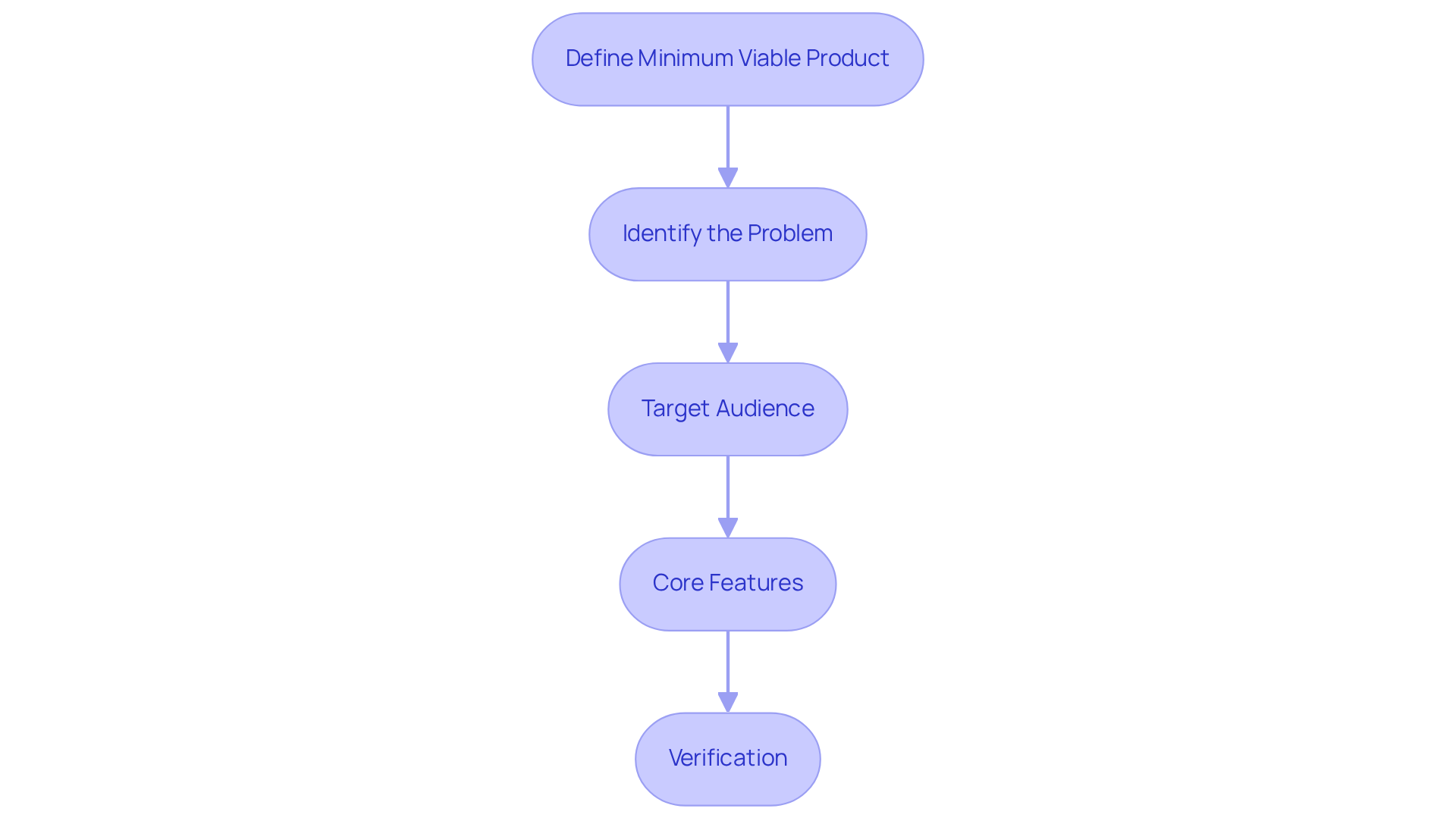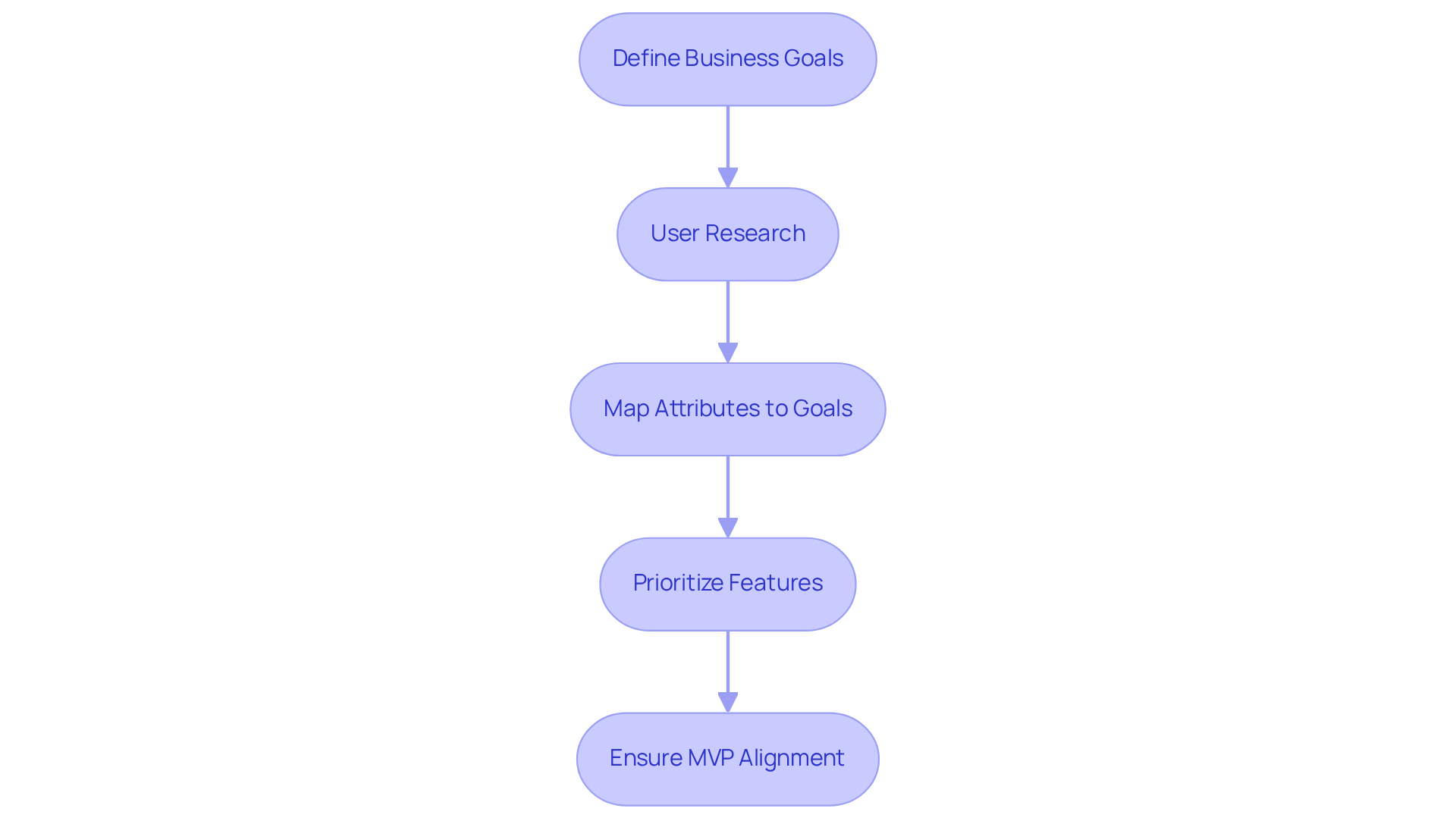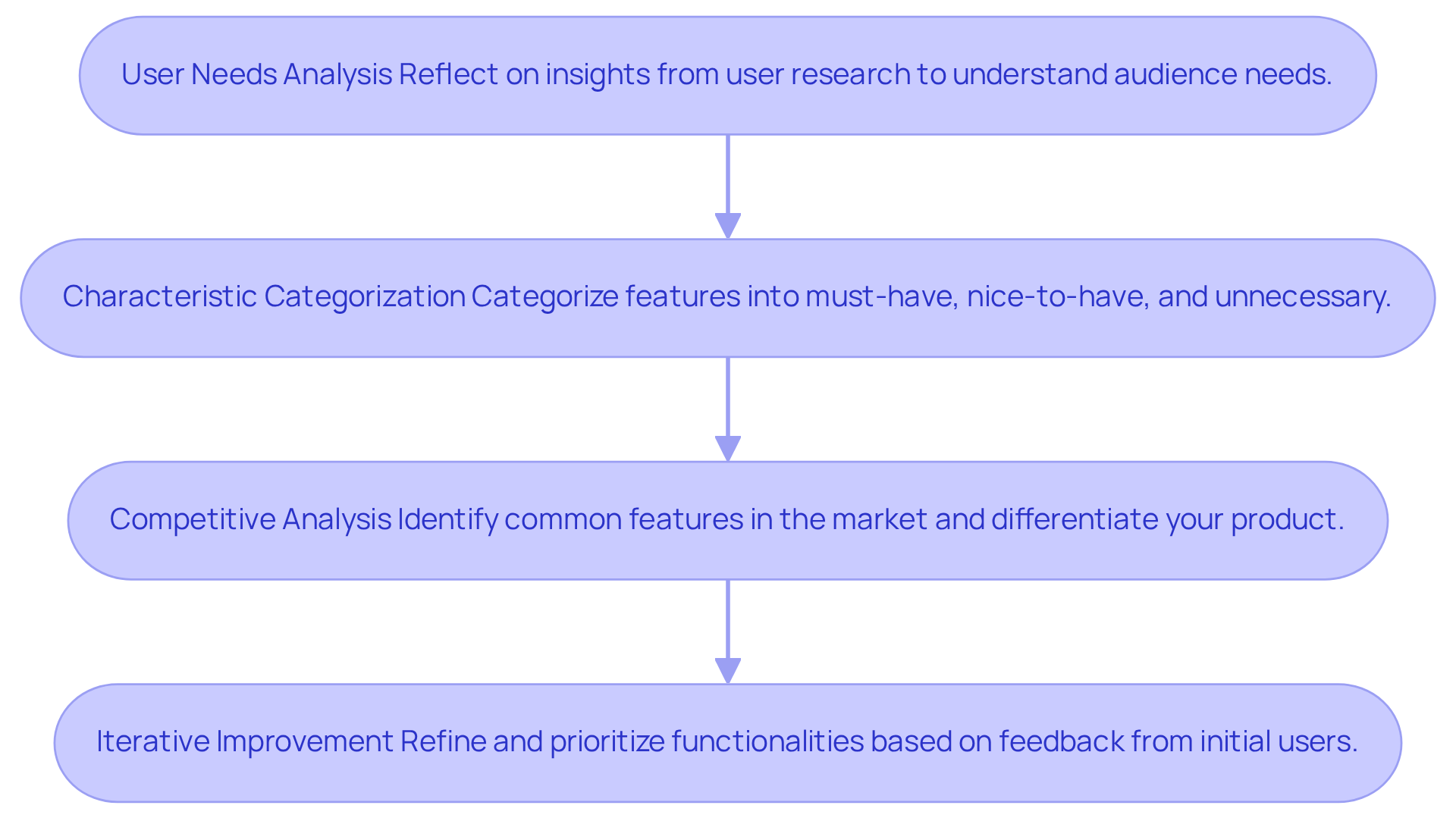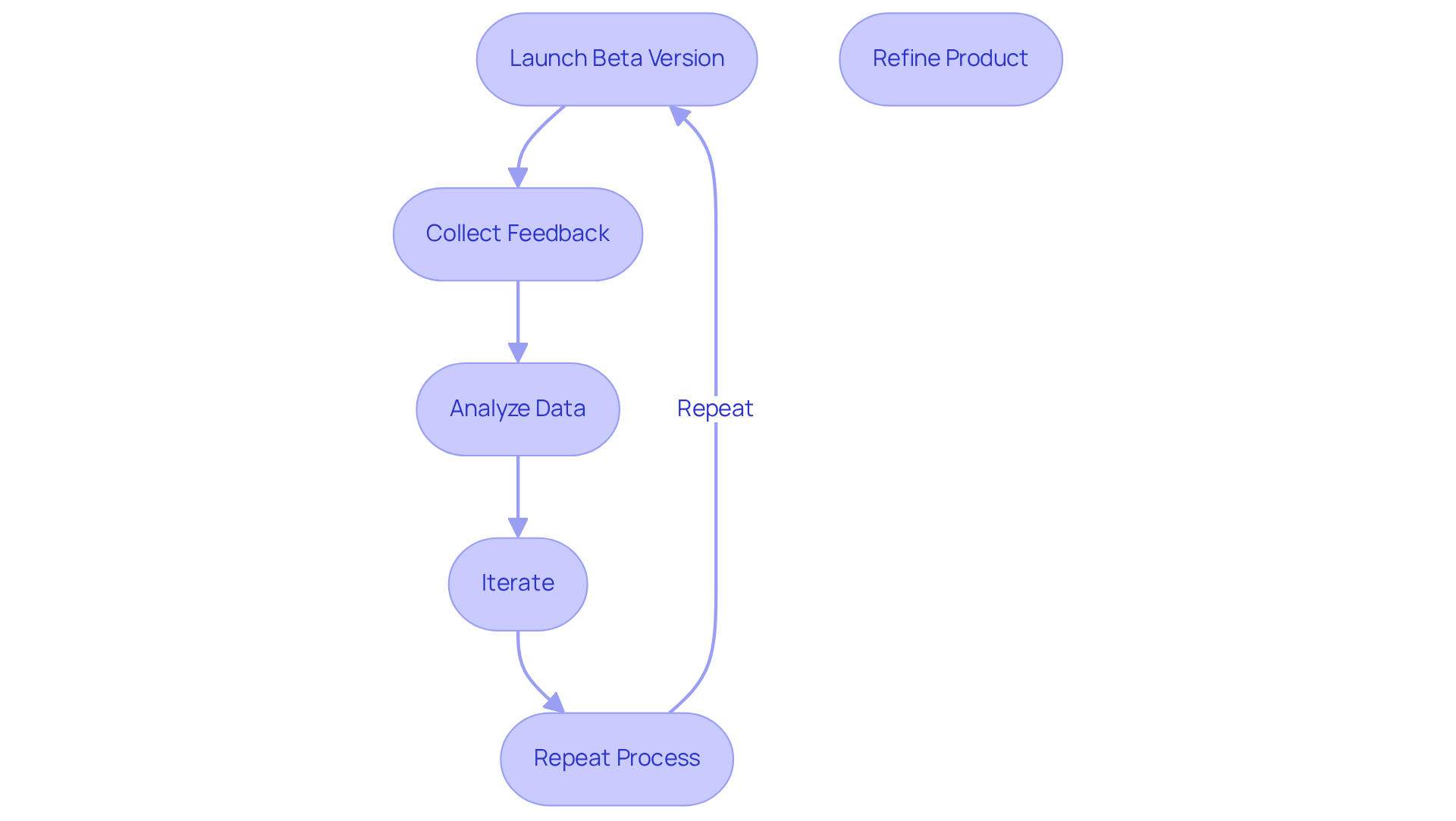Overview
In the journey of building a startup, one of the most pressing challenges founders face is aligning product features with the true needs of their users. This struggle can often feel overwhelming, leaving many to question whether their offerings will resonate with their target audience. Without a clear understanding of user needs, the risk of misallocation of resources grows, leading to frustration and uncertainty.
However, there is a nurturing path forward. The concept of a Minimum Viable Product (MVP) emerges as a beacon of hope. By focusing on identifying core features through user research and feedback, startups can create products that genuinely connect with their audience. This approach not only minimizes resource investment but also significantly enhances the likelihood of success. It’s a way to listen to the voices of your users, ensuring that what you build truly serves them.
As you navigate this process, remember that you are not alone. Many founders have walked this path and found success by embracing the MVP strategy. By prioritizing user needs, you can foster a deeper connection with your audience and create offerings that truly matter. Embrace this journey with compassion and confidence, knowing that each step brings you closer to a product that resonates with those you aim to serve.
Introduction
In the fast-paced world of startups, many founders find themselves facing the daunting challenge of transforming a brilliant idea into a successful product. This journey often feels overwhelming, as the pressure to succeed can weigh heavily on their shoulders. At the heart of this process lies the concept of the Minimum Viable Product (MVP), a crucial tool that not only helps validate market hypotheses but also minimizes resource expenditure. By focusing on what truly matters, founders can alleviate some of the stress associated with launching their ideas.
This article aims to guide you through the essential steps for defining an MVP that not only meets user needs but also aligns seamlessly with your business objectives. How can you, as a founder, effectively navigate the complexities of user feedback and iterative development? By embracing these challenges, you can ensure that your MVP resonates deeply with your target audience, paving the way for a more fulfilling entrepreneurial journey. Together, let’s explore how to turn your vision into reality with compassion and understanding.
Define the Minimum Viable Product (MVP)
A Minimum Viable Offering (MVO) represents a simplified version of a product, focusing solely on the essential features needed to satisfy early adopters and validate a concept. For many startup founders, the journey of bringing an idea to life can feel overwhelming. The primary goal of an MVO is to test market hypotheses and gather valuable feedback from participants, all while minimizing resource investment. To help you navigate this process, consider these supportive steps:
- Identify the Problem: Take a moment to clearly articulate the specific issue your offering aims to solve. is crucial.
- Target Audience: Identify who your early adopters are and delve into their needs and preferences. Their insights can shape your offering.
- Core Features: Determine the minimum features that will provide real value to these individuals, ensuring alignment with their pain points.
- Verification: Create the MVO to facilitate feedback gathering, allowing you to confirm your assumptions and refine your approach based on insights from real users.
By concentrating on these aspects, you not only develop an offering that meets user needs but also reduce development costs and timelines. It’s worth noting that around 50 million startups are launched each year, with approximately 137,000 emerging daily. Many of these startups embrace the MVP define approach to improve their chances of success. Experts emphasize the importance of MVOs in development, as they help to MVP define vital tools for innovation and learning. As Eric Ries wisely states, "The minimum viable version is that iteration of a new offering which allows a team to gather the maximum amount of validated learning about customers with the least effort." By prioritizing customer feedback over feature completeness, startups can pivot effectively based on real-world insights, leading to more successful outcomes.
Moreover, conducting customer interviews is essential for gaining deeper insights into the needs, preferences, and pain points of your target audience. This understanding further informs the MVO development process. The Build-Measure-Learn iterative feedback loop is key to enhancing your MVO based on consumer data, ensuring that your offering evolves in line with customer expectations. Remember, you are not alone on this journey; many have walked this path and found success by embracing the MVO approach.

Align MVP with Business Objectives and User Needs
To effectively align your MVP with business objectives and user needs, let’s explore some important steps together:
- Define Business Goals: It’s essential to clearly articulate your business objectives to MVP define. Think about goals like enhancing customer satisfaction or capturing a larger market share. These goals serve as your guiding light.
- User Research: Engage in various methods such as surveys, interviews, and focus groups to gather valuable insights into your and requirements. For instance, a recent initiative revealed that comprehensive consumer research led to an item with 88% purchase intent, underscoring the importance of truly understanding consumer needs. As Jared Schwitzke wisely noted, 'RNO1's design-first approach and significant outcomes' underscore the necessity of aligning attributes with client expectations.
- Map Attributes to Goals: Consider creating a matrix that links each element of your MVP to specific business objectives and customer requirements. This organized approach ensures that every aspect of your offering serves a meaningful purpose.
- Prioritize Features: Focus on features that provide maximum value to users while aligning with your business objectives. This dual focus ensures that your MVP is both user-centric and strategically sound.
By ensuring that your MVP define effectively addresses client needs alongside business objectives, you can create a product that resonates with your audience and drives significant business success. The creation of the Ayadi teletherapy platform beautifully illustrates this approach, as research on individuals guided its design and functionality, leading to a seamless experience. Together, we can create solutions that not only meet market demands but also foster genuine connections with our users.

Identify Core Features and Functionalities
Identifying the core features and functionalities of your MVP can feel overwhelming, but you're not alone in this journey. Many startup founders grapple with understanding what truly matters to their audience. To navigate this process compassionately, consider these steps:
- Conduct a User Needs Analysis. Take a moment to reflect on the insights gathered from user research. What aspects resonate most with your target audience? Understanding their needs is crucial to MVP definition.
- Move to Characteristic Categorization. It can be helpful to categorize features into three groups: must-have, nice-to-have, and unnecessary. Focus your energy on those essential elements that directly address the main issues your users face. This clarity will help MVP define the direction of your development.
- Engage in a Competitive Analysis. Look at your rivals to identify common characteristics in the market. What features do they offer, and how can you differentiate your product? This insight can illuminate opportunities that help to MVP define.
- Embrace Iterative Improvement. Utilize feedback from your initial participants to . This iterative approach not only enhances your product but also ensures it genuinely meets the needs of your audience.
By concentrating on these essential features, you can define an MVP that is both functional and appealing, laying a solid groundwork for future enhancements. Remember, each step you take is a part of your growth, and your dedication to understanding your users will pave the way for success.

Test and Iterate Based on User Feedback
Testing and iterating can help you mvp define based on user feedback, but it can feel overwhelming. Many founders struggle with how to effectively gather insights that truly reflect user needs. This can lead to frustration and uncertainty about how to move forward.
To ease this process, consider launching a to help mvp define. By releasing it to a select group, you not only gather initial feedback on its functionality and usability but also create a sense of community among early users. Their insights are invaluable, as they help shape the product into something that resonates with others.
Next, actively collect feedback through surveys, interviews, and analytics tools. This approach allows you to gather both qualitative and quantitative insights, giving you a fuller picture of the user experience. Remember, every piece of feedback is a stepping stone towards improvement.
Once you have this data, take the time to analyze it. Look for common pain points and enhancement requests. This is where the heart of your users' needs lies, and addressing these areas can help you mvp define your product so that it truly serves its purpose.
Now, it’s time to iterate. Make the necessary adjustments based on what your users have shared. This could mean incorporating new features, enhancing existing ones, or even removing those that aren't resonating. Each iteration brings you closer to a product that meets user expectations.
Finally, embrace the idea of repeating this process. Continue testing and iterating, using each round of feedback to refine your offering further. By adopting this user-centered approach, you can ensure that the MVP define evolves in harmony with user expectations and market demands. This nurturing journey ultimately leads to a more successful product, one that reflects the voices of those it aims to serve.

Conclusion
Defining a Minimum Viable Product (MVP) can feel overwhelming for many startups. It's a crucial step that helps align offerings with user needs and business objectives. By honing in on the essential features that deliver real value to early adopters, startups can effectively test their market hypotheses. This process allows them to gather invaluable feedback while minimizing resource investment. Such an approach not only increases the chances of success but also nurtures a deeper connection with users, ensuring that the product evolves in harmony with their expectations.
Throughout this article, we’ve explored key strategies that can help you navigate this journey. Identifying the core problem your product addresses, engaging in thorough user research, and prioritizing features that resonate with both customer needs and business goals are vital steps. The iterative process of testing, gathering feedback, and refining your MVP is emphasized as a practice that enables you to adapt your offerings based on real-world insights. By embracing these strategies, you can create a product that not only resonates with your target audience but also drives significant business success.
Ultimately, defining an MVP is not just about launching a product; it’s about crafting solutions that genuinely meet market demands and foster meaningful connections with users. Embracing the MVP approach empowers you to innovate, learn, and grow, paving the way for future success. Therefore, it’s essential to prioritize user feedback and remain committed to an iterative development process. This commitment ensures that your MVP not only meets user needs but also aligns with broader business objectives, creating a path toward a thriving future.
Frequently Asked Questions
What is a Minimum Viable Offering (MVO)?
A Minimum Viable Offering (MVO) is a simplified version of a product that focuses on essential features needed to satisfy early adopters and validate a concept.
What is the primary goal of creating an MVO?
The primary goal of an MVO is to test market hypotheses and gather valuable feedback from participants while minimizing resource investment.
What are the steps to develop an MVO?
The steps to develop an MVO include identifying the problem your offering aims to solve, targeting your audience, determining core features that provide value, and creating the MVO for feedback gathering.
Why is it important to identify the problem before developing an MVO?
Clearly articulating the specific issue your offering aims to solve is crucial for ensuring that the MVO addresses real user needs.
How can understanding the target audience benefit the MVO development process?
Identifying early adopters and understanding their needs and preferences can shape the offering to better align with what users actually want.
What role does customer feedback play in the MVO approach?
Customer feedback is prioritized over feature completeness, allowing startups to pivot effectively based on real-world insights, leading to more successful outcomes.
What is the Build-Measure-Learn feedback loop?
The Build-Measure-Learn feedback loop is an iterative process that enhances the MVO based on consumer data, ensuring that the offering evolves in line with customer expectations.
How common is the launch of new startups that use the MVP approach?
Approximately 50 million startups are launched each year, with around 137,000 emerging daily, many of which embrace the MVP approach to improve their chances of success.
What quote by Eric Ries emphasizes the importance of the MVP approach?
Eric Ries states, "The minimum viable version is that iteration of a new offering which allows a team to gather the maximum amount of validated learning about customers with the least effort."




